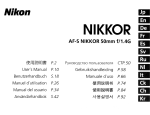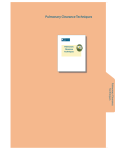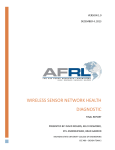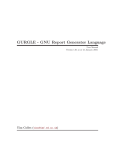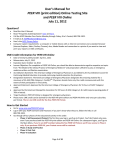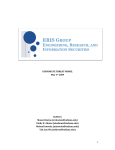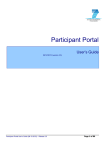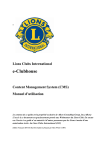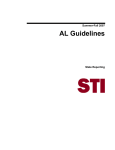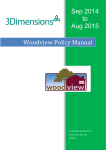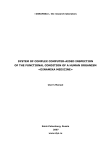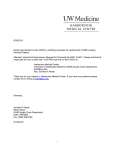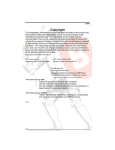Download PRIMARY CARE CLINIC - Ministry of Health
Transcript
A GUIDE TO ORGANISING A PRIMARY CARE CLINIC DURING AN INFLUENZA PANDEMIC Version 3 (Feb 2014) A GUIDE TO ORGANISING A PRIMARY CARE CLINIC DURING AN INFLUENZA PANDEMIC Version 3 (Feb 2014) CONTENTS PAGE 1 BACKGROUND 2 2 NATIONAL RESPONSE – TREATMENT STRATEGY 3 3 PRIMARY CARE RESPONSE FRAMEWORK 4 4 ORGANISING A PRIMARY CARE CLINIC DURING INFLUENZA PANDEMIC 6 5 PRIMARY CARE CLINIC WORK PROCESSES DURING INFLUENZA PANDEMIC 9 6 LOGISTIC SUPPORT PLAN FOR CLINICS DURING INFLUENZA PANDEMIC 12 7 GUIDELINES FOR THE USE OF PERSONAL PROTECTIVE EQUIPMENT (PPE) DURING INFLUENZA PANDEMIC 14 8 CLEANING GUIDELINES FOR HEALTHCARE FACILITIES 16 ANNEXES ANNEX A SUMMARY TABLES FOR RESPONSE MEASURES UNDER THE REVISED DORSCON MATRIX 21 ANNEX B ADVICE TO PUBLIC ON DORSCON ALERT LEVELS 25 ANNEX C SCHEMATIC LAYOUT OF A CLINIC IN INFLUENZA PANDEMIC 26 ANNEX D PERSONAL PROTECTIVE EQUIPMENT 27 ANNEX E PATIENT SCREENING FORM 28 ANNEX F HEALTH CHECK SYSTEM: CHECK LIST AND REPORT MODULES A GUIDE TO ORGANISING A PRIMARY CARE CLINIC DURING AN INFLUENZA PANDEMIC 29 Version 3 (Feb 2014) CHAPTER 1 - BACKGROUND 1. This Primary Care Clinic Guide is the third update of the guide to organising a primary care clinic during a pandemic. This document should be read together with the MOH Readiness and Response Plan for Influenza and other respiratory diseases (revised Oct 2013). 2. The threat of an Influenza pandemic continues with the continued outbreaks of avian influenza (AI) in domestic and wild birds, and increasing numbers of human cases in the world. The world experienced a pandemic H1N1 pandemic outbreak in 2009, and saw the emergence of H7N9 and MERS-CoV in 2013. Although the influenza virus is the current contender, a world-wide pandemic can also be caused by other viruses and we must be prepared for the eventuality. 3. Ministry of Health (MOH) has worked out an operationally ready national influenza pandemic plan since 2005, and there is an ongoing effort to review and enhance the plan. 4. In an influenza pandemic, our treatment strategy is to provide as many treatment facilities as possible to minimise the need for people to travel to seek medical treatment, thus mitigating the spread of the disease, and also to cope with the surge in demand on healthcare services. The primary healthcare services in the community have been identified as the most appropriate framework to manage the ill in a pandemic. 5. Private primary care clinics1 form the larger proportion of the primary healthcare sector. MOH, in collaboration with the Singapore Medical Association (SMA) and College of Family Physicians Singapore (CFPS), has together developed the Primary Care Pandemic Response Framework to enable government polyclinics and the private primary care clinics to work together to provide treatment for influenza cases. In this framework, in the event of an influenza pandemic, all the registered participating primary care clinics, called the Pandemic Preparedness Clinics (PPCs), will be equipped with PPE and supplied with anti-viral drugs for treatment and staff prophylaxis so that they can continue to manage the sick in the community, including those ill from influenza. AIM 6. The aim of this Guide is to provide an overview of the Primary Care Pandemic Response Framework and information on preparing and organising a Primary Care Clinic during a pandemic, including infection control requirements and the concept of logistics support. 1 Primary care clinics broadly encompass community based GP clinics (i.e. nonhospital/medical centre based). The total number in year 2013 is approximately 1,400. 2 A GUIDE TO ORGANISING A PRIMARY CARE CLINIC DURING AN INFLUENZA PANDEMIC Version 3 (Feb 2014) CHAPTER 2 - NATIONAL RESPONSE PLAN – TREATMENT STRATEGY 7. Estimated Outpatient Load. In order to estimate the impact of an influenza pandemic occurring in Singapore, a software programme, FluAid, developed by US CDC, was used to study the trends. The projected number of cases requiring outpatient treatment over a 6-week2 period is around 700,000 while the peak number of outpatients is estimated to be 360,000 a week. 8. National Strategy for pandemic response. The national strategy is to establish an effective surveillance system to detect the importation of a novel acute respiratory pathogen with pandemic potential and to mitigate the consequences when the first wave hits. Where vaccine production is possible, vaccination will be provided as soon as a vaccine becomes available, which is likely to be beyond the first wave. 9. Sustaining the nation through the first epidemic wave. The objective is to sustain the nation through the first epidemic wave by minimising mortality and morbidity through the use of measures proportional to the assessed public health impact, while ensuring preparedness for vaccination of the entire population when a vaccine becomes available. 10. Recommended national response measures. The recommended national response measures are dependent on the phase of the local epidemic and the assessed public health impact of the epidemic. See Annex A in this Guide for the summary tables of response measures under each pandemic scenario, taken from the MOH Readiness and Response Plan for Influenza and other respiratory diseases. URL: http://www.moh.gov.sg/content/mohweb/home/diseases_and_conditions /pandemic-preparedness.html. 2 6 weeks is the planning assumption made for one pandemic wave. 3 A GUIDE TO ORGANISING A PRIMARY CARE CLINIC DURING AN INFLUENZA PANDEMIC Version 3 (Feb 2014) CHAPTER 3 - PRIMARY CARE RESPONSE FRAMEWORK 11. Intent. There are approximately 1,400 private primary care clinics in Singapore and in normal times they manage 82% of outpatient caseload while Polyclinics manage 18%. The overall intent is to maintain normalcy as much as possible and to limit movement of the sick to reduce the likelihood of spreading the infection in the community in each stage of the pandemic. 12. Concept. Polyclinics and primary care clinics provide specific treatment to influenza cases and continue to provide care to non-influenza patients with strict infection control measures in place. To reduce the case load, the chronic sick will be provided with 3-6 months’ worth of medication and advised to seek consultation only if ill. Through the media, the public will be advised to go to any nearby GP clinic or PPC for assessment and treatment for influenza-like symptoms. Severe cases will be referred to acute restructured hospitals for further treatment. 13. Immediate Response. In response to a possible novel pathogen case or outbreak, medical surveillance will trigger an immediate response workflow. MOH will provide timely situational updates to agencies and coordinate the initial interagency preparation for DORSCON (Disease Outbreak Response System Condition) activation (see the following section). An assessment of the threat and impact to public health will be made, which will include a clinical assessment and the extent of disease spread. Medical directives on case management and infection control measures to undertake in healthcare institutions will be issued by MOH, where necessary. 14. Logistics Supply. All primary care clinics are required to have a baseline stockpile of one week's supply of PPE in peacetime. In addition, participating PPCs’ clinic doctors and support staff will be provided with the same protection as public sector healthcare workers during a pandemic. Such provision from MOH will include: a. PPE supply for 6 weeks (for doctors and clinic support staff3) at no cost to the PPC. Additional PPE may be supplied earlier based on assessed needs; b. Anti-viral prophylaxis supply for 6 weeks (for doctors and clinic support staff4) at no cost to the PPC; c. Anti-viral drugs for treatment of patients with influenza-like illness (routine replenishment cycle will be established) on consignment basis 15. Crowd Management and Security. We expect that while there could be larger than usual crowds at some of the clinics during the pandemic, 3 Planning ratio of up to 4 clinic support staff for every attending doctor. 4 A GUIDE TO ORGANISING A PRIMARY CARE CLINIC DURING AN INFLUENZA PANDEMIC Version 3 (Feb 2014) they are likely to remain orderly, given our policy to provide treatment to all patients suggestive of influenza. Notwithstanding this, clinics will need to manage the crowd effectively and carry out their operations smoothly. 16. Communications. A timely, accurate, efficient, total communication network is of paramount importance. a. Public Communications. In a pandemic, MOH will work with other agencies such as MCI and HPB to develop the media packages to educate and guide the public on the national response and the primary healthcare framework. MOH will coordinate with the media to push out the public messages to gain the support and confidence of the public. See Annex B in this Primary Care Clinic Guide on the advice to the public at each DORSCON alert level. b. Primary Care Response Internal Communications. Current communication systems and frameworks will continue to apply. These will include advisories, directives and notification systems such as CRF and the MedAlert. While all means of communication will be exploited, MOH strongly encourages clinics to have internet access as much of the information will be pumped through the Net and e-mail. 17. Administration. There is a need to pay attention to data collection, cost-recovery of items sourced from MOH’s stockpile, and handling of difficult patients. a. Data collection. Effective surveillance requires timely and as near complete reporting of suspect and confirmed cases from health care providers. MOH will provide a standard template for data collection when the pandemic is declared and will advise the clinics on the submission process. b. Cost-recovery for antivirals, PPE and other items sourced from MOH’s stockpile. As clinics strive to cost-recover for supplies sourced from MOH’s stockpile, clinics are reminded to put patient’s interest and affordability first. c. Dealing with difficult patients. Some patients can be difficult to handle with regards to compliance of preventive measures. Explanation and persuasion should be used as far as possible. If the patients concerned refuse to co-operate, their details could be submitted to MOH for MOH to exercise the provisions of the Infectious Diseases Act (IDA). 5 A GUIDE TO ORGANISING A PRIMARY CARE CLINIC DURING AN INFLUENZA PANDEMIC Version 3 (Feb 2014) CHAPTER 4 - ORGANISING A PRIMARY CARE CLINIC DURING AN INFLUENZA PANDEMIC 18. General principles. Polyclinics and primary care clinics will continue to treat both patients with influenza-like illnesses (ILI) and patients who do not have ILI. a. Primary care clinics need to prepare to manage larger than normal crowds and focus on reducing the risk of cross transmission of pathogens within the clinic. b. Patients and staff need to be protected and it is necessary to adopt stringent infection control practices i.e. use of PPEs, and modifying the clinic workflow and work processes to effectively segregate the patients with ILI from patients with no ILI. c. Scheduling of clinic hours for ILI and non-ILI cases is also strongly recommended to further segregate patients especially for clinics that do not have separate consultation rooms. d. This Guide provides a generic structure which clinics will need to customise to fit the constraints of their location. 19. Functional Areas. A schematic clinic layout for one and two consultation rooms is provided in Annex C for reference. In a pandemic, a primary care clinic will comprise the following areas: a. b. c. d. e. f. Screening Counter ILI Patient and Non-ILI Patient Waiting (Holding) Areas Registration Counter Consultation Room(s) (preferably segregated for ILI and non- ILI) Transfer Room/Area Dispensary and Payment Counter 20. Screening Counter. The Screening Counter acts as a triage point for incoming patients and staff. It is located near the clinic’s entrance. The proposed furniture, equipment/consumables and stationery for the counter are as follows: a. b. c. d. e. f. g. h. i. j. k. Table (x1) and chairs (x2) Biohazard waste bins with lids (c/w biohazard waste bags) Normal waste bins (c/w trash bags) Pens Queue number tags (if required) Patient Screening forms Plastic tray to place the fresh/duly completed forms (if any) Clinical thermometers (e.g. digital thermo scan) Disposable protective sheaths (e.g. disposable ear probes) Disposable examination gloves Surgical masks (for patients) 6 A GUIDE TO ORGANISING A PRIMARY CARE CLINIC DURING AN INFLUENZA PANDEMIC Version 3 (Feb 2014) l. m. Alcohol hand-rub disinfectant (e.g. chlorhexidine 0.5%) Surface disinfectant (e.g. bleach, alcohol wipes) 21. ILI Patient and Non-ILI Patient Waiting Areas. The clinic’s patient waiting area should be segregated into two distinct areas to ensure a physical separation of ILI from non-ILIpatients. a. If space is a constraint, clinics could explore setting up one or both the waiting areas outside the clinic but prior approval would be needed from Town Councils or the building management. Provide biohazard waste bins for patients’ use. b. Clinics with only one consultation room should consider separate clinic hours for ILI and non- ILIpatients. 22. Registration Counter. The Registration Counter can be organised as in normalcy. The counter will need a computer with internet access to enable the staff to access the Health Check System to identify repeat patients. 23. Consultation Room(s). Consultation Room(s) may be organized as in normalcy. Where possible, clinics should have two Consultation Rooms, one for ILI and the other for non-ILI patients. 24. Transfer Room/ Area. Each clinic needs to have a Transfer Room/ Area to enable influenza patients awaiting transfer to designated flu hospitals to await ambulance transport away from the other patients. The room/area can also be used for patients who require emergency attention. The suggested furniture, equipment/consumables and stationery for the Transfer Room/Area are as follows: a. b. c. d. e. f. g. h. i. j. k. l. m. n. Table (x1) and chairs (x2) Biohazard waste bins with lids (c/w biohazard waste bags) Normal waste bins (c/w trash bags) Pens Referral letters (to flu hospitals), envelopes, carbon papers Writing note pads Ink stamps (name, date etc.) Stethoscope BP set (including paediatric and adult cuffs) Clinical thermometers and disposable protective sheaths Disposable examination gloves Disposable dressing sets Wooden tongue depressors Alcohol hand-rub disinfectant 25. Dispensary and Payment Counter. The Dispensary and Payment Counter can be organised as in normalcy. This counter can be collocated or next to the Registration Counter for better coordination. 7 A GUIDE TO ORGANISING A PRIMARY CARE CLINIC DURING AN INFLUENZA PANDEMIC Version 3 (Feb 2014) The counter will need a computer with access to the internet for the staff to key in patient information when anti-viral drugs are dispensed. 8 A GUIDE TO ORGANISING A PRIMARY CARE CLINIC DURING AN INFLUENZA PANDEMIC Version 3 (Feb 2014) CHAPTER 5 - PRIMARY CARE CLINIC WORK PROCESSES DURING AN INFLUENZA PANDEMIC 26. Key principle. The key principle in setting out the patient flow is the segregation of patients with influenza-like illness (ILI) from non-ILI patients so as to minimize spread of infection by contact. The diagram illustrating the flow of patients through the Primary care clinic is shown in Annex C of this PPC Guide. Attention should be paid to the following: a. Masks and PPE are useful physical barriers and should be used by ILI patients and those in contact with them. b. Separation can also be achieved through physical distance between the two groups of ILI patients and non-ILI patients and by staggering their activity at common areas such as the Registration and Dispensary/Payment counters. c. Clinics with single consultation rooms are strongly encouraged to consider rescheduling their consultation hours for patients with ILI and non-ILI patients. d. Clinics need to consider signage to facilitate the flow of patients and to reduce anxiety especially when there are crowds. 27. Influenza Screening Process. The Screening Counter will screen all patients and staff entering the clinic for influenza-like symptoms. Other visitors to the clinic (including delivery, dispatch personnel) should be managed outside the clinic. The staff assigned to the Screening Counter will have the following roles: a. Don full PPE (refer to Annex D in this Primary Care Clinic Guide on PPE guidelines) b. Inform all staff and patients that it is compulsory to have their body temperature taken prior to entry into the clinic. c. Assist/facilitate the patient to complete the Screening Record (see Annex E for a sample) which will include contact information for community contact tracing purposes4. d. Screen every patient for ILI. e. Provide all patients with a surgical mask and advice on its use. f. For a patient with ILI, the Screening Counter staff shall: 4 In a pandemic (DORSCON RED), quarantine operations will be carried out till no longer operationally feasible. Contact details of visitors will continue to be recorded until quarantine measures are ended. Contact details include - date and time of visit, name of visitor/patient, IC number, address, telephone number. 9 A GUIDE TO ORGANISING A PRIMARY CARE CLINIC DURING AN INFLUENZA PANDEMIC Version 3 (Feb 2014) i. ii. Reassure him/her. Usher the patient to the ILI Waiting Area. g. Patients without influenza-like symptoms will be ushered to the clinic’s Non-ILI Waiting Area. h. Hand the completed Screening Record to the Registration Counter for registration. 28. Registration Process. Registration of patients with ILI requires priority and those coming for anti-viral drugs require checking if they have received a prescription already. a. Registration may be as per peacetime operations. However, priority should be given to patients in the ILI Waiting Area. Registration can commence based on the details provided in the patient Screening Record. b. In a pandemic, there will be high demand for anti-viral drugs and there may be instances of patients seeking a second prescription from the doctors. To reduce this behaviour, clinics will need to access the Health Check System (HCS) to check on the patient database to determine if the patient has been treated previously. It is recommended that this check is done at Registration or at the latest, at the beginning of the consultation. Patients who have received anti-viral treatment within a specified period (as determined by MOH) ought not to receive a second prescription. Please see Annex F for more details. 29. Consultation Process. It is recommended that flu patients are physically segregated from non-flu patient and a check with the HCS be done. a. Clinics with only one consultation room need to take greater care to reduce the possibility of cross infection. These clinics are strongly encouraged to reschedule their consultations for ILI and non-ILI patients. b. For clinics with two or more Consultation Rooms, the rooms should be designated for ILI and non-ILI patients. If the clinic has two (or more) doctors, then each doctor can be designated to a fixed consultation room. If there is only one doctor, he/she will need to shuttle between the two consultation rooms. c. Attending doctors and nurses need to put on full PPE and adopt the necessary infection control measures. d. If the check with HCS has not been done at Registration, the doctor should do so at the start of the consultation. In general, during an influenza pandemic, all patients with flu-like symptoms 10 A GUIDE TO ORGANISING A PRIMARY CARE CLINIC DURING AN INFLUENZA PANDEMIC Version 3 (Feb 2014) will receive treatment with anti-viral drugs. However, patients who have received anti-viral treatment for flu within a specified period (as determined by MOH) ought not to receive a second prescription. 30. Dispensing and Payment Process. Logging all anti-viral prescriptions with HCS is a must. The patient flow for dispensing and payment is detailed below: a. The Registration Counter staff may double up to man the Dispensing and Payment Counter as in normalcy. Upon completion of the consultation process, medication will be dispensed to the patient as per doctor’s prescription. b. Clinic staff are required to log (report) all antiviral prescriptions with MOH via its web-based anti-viral reporting IT system, known as Health Check System (HCS). Refer to Annex F for the logging in and reporting procedure. 31. Exiting the Primary Care Clinic. For clinics with two access points (e.g. main entrance and back door), the entrance and exit route should be separated to minimise criss-crossing of patient flows. 32. Process for Referral of Patients with ILI to Hospital. If referral or transfer of an patient with ILI to a designated hospital is indicated, the clinic staff shall activate the patient transport process. The patient should be held in the Transfer Room/Area. The doctor or nurse should ensure that the patient is clinically stable while awaiting the arrival of the transfer ambulance. Clinic staff need to: a. Activate the ambulance service (993) to transport the patient with ILI to designated hospital. b. Provide the following information: i. Name of requesting staff and doctor ii. Clinic name, contact numbers, address, nearest geographical landmark if possible. iii. Patient’s full name, NRIC/ Passport/Other ID No., Gender, Age iv. Patient’s symptoms (Note: for routine referral, it is NOT necessary to contact the designated hospital’s Emergency Department) 33. Cleaning Procedures. Cleaning is important to reduce the level of contamination on all surfaces and minimise the transmission of infection by indirect contact with surfaces contaminated with droplets. The cleaning guidelines are described in Chapter 7 of this PCC Guide. 11 A GUIDE TO ORGANISING A PRIMARY CARE CLINIC DURING AN INFLUENZA PANDEMIC Version 3 (Feb 2014) CHAPTER 6 - LOGISTIC SUPPORT PLAN FOR CLINICS DURING AN INFLUENZA PANDEMIC GENERAL 34. This section describes the logistics support plan for primary care clinics during a pandemic pertaining to PPE and anti-viral drugs. SELF SUFFICIENCY 35. All primary care clinics need to be self-sufficient for at least 1 week in an outbreak, after which, critical medical supplies will be pushed to the participating PPCs by MOH within a designated time-frame. STAFF PERSONAL PROTECTION EQUIPMENT (PPE) 36. PPE stocks in response to a pandemic are stored and managed at 2 levels (i.e. primary care clinics and MOH): 37. a. Level 1. All primary care clinics are required to stockpile 1 week supply of PPE to meet their immediate surge demand. b. Level 2. MOH maintains a national PPE stockpile comprising N95 masks, surgical masks, examination gloves and isolation gowns which are kept with a logistics service provider who will push the supplies to the PPCs when needed. This Level 2 arrangement is applicable to only the participating PPCs. All clinics are therefore encouraged to sign up to be PPCs. When activated by MOH, each PPC will receive PPE for staff5 use. a. 5 The national N95 mask stockpile. The national N95 mask stockpile consists of the models listed below. To facilitate distribution, each primary care clinic is encouraged to provide MOH with information on the N95 mask make and model suitable for each staff (subjected to planning ratio 6 ceiling), using the reply form in Annex D of this PPC Guide. Planning ratio of up to 4 clinic support staff for every attending doctor. 12 A GUIDE TO ORGANISING A PRIMARY CARE CLINIC DURING AN INFLUENZA PANDEMIC Version 3 (Feb 2014) b. Mask fitting for the correct N95 Mask make and model. It is recommended that clinic staff undergo proper mask-fitting of the N95 mask (make and model) supplied under the National Stockpile. Make of N95 Mask 3M Model of N95 Mask 1870 8210 8110S Note: DRAEGAR Masks are no longer part of the list of items supplied to PPCs under the National Stockpile SUPPLY OF ANTI-VIRALS 38. Anti-Viral Drugs for Staff Prophylaxis. Each PPC will be supplied with anti-viral drugs for prophylactic use by attending doctors and clinic support staff when required. The anti-viral drugs for prophylaxis will be delivered to the clinic point of contact at the same time as the PPE. 39. Anti-viral Drugs for Treatment. Primary care clinics are free to use commercial sources of Tamiflu for treating patients, without being subject to any MOH administrative requirements. They can also request for 50 boxes of Tamiflu from the National Stockpile on consignment basis (without any initial charges) for treating patients, to be prescribed based on MOH guidelines. They will be charged for the amount of Tamiflu used. MOH vendor will then resupply the clinics on a weekly basis based on the usage. 13 A GUIDE TO ORGANISING A PRIMARY CARE CLINIC DURING AN INFLUENZA PANDEMIC Version 3 (Feb 2014) CHAPTER 7 - GUIDELINES FOR THE USE OF PERSONAL PROTECTIVE EQUIPMENT (PPE) IN PRIMARY CARE SETTINGS DURING AN INFLUENZA PANDEMIC (Ref: MOH Influenza Pandemic Readiness and Response Plan, May 2007, www.moh.gov.sg) 40. The risk levels for Health Care Workers6 (HCWs) have been classified according to the nature of the role provided by the person working in the healthcare environment in relation to the likelihood of close contact with person(s) with potential influenza. The nature of the roles of HCWs working in the healthcare environment is as follows: a. HCWs who can maintain more than 1 metre contact distance from patients with potential influenza. b. HCWs who may encounter occasional situations where they may come into close contact7 with patients with potential influenza. c. HCWs who are likely to come into close contact with patients with potential influenza but who are not involved in procedures where aerosolisation of secretions is produced. d. HCWs who are likely to come into close contact with patients with potential influenza and who also have a high likelihood of contact with respiratory secretions, particularly from aerosolisation. 41. PPE requirements in relation to risk levels are shown in Table 1 of Annex D. The PPE requirements may be stepped up if the situational assessment of the risk is deemed higher. 42. PPE requirements supplement and do not replace standard precautions and best practices for infection control. 43. Standard Precautions. Standard Precautions are designed to reduce the risk of transmission of micro-organisms from both recognized and unrecognized sources of infection in the healthcare setting. Standard Precautions apply to blood, all body fluids and secretions, excretions except sweat, regardless of whether they contain visible blood, nonintact skin and mucous membranes. Standard Precautions emphasizes the importance of hand washing after touching blood, body fluids, secretions, excretions and contaminated items and also after the removal of gloves, between patient contact and when indicated. Standard precautions include: a. 6 7 Hand Hygiene. Hand washing is the single most important method of infection control. HCWs should already be familiar with the 7 steps to hand washing. Thereafter, hands should be dried Includes administrative and other support staff. A distance of less than or equal to 1 metre. 14 A GUIDE TO ORGANISING A PRIMARY CARE CLINIC DURING AN INFLUENZA PANDEMIC Version 3 (Feb 2014) thoroughly, preferably with a disposable hand towel. Alternatively, a hand rub may be used if soap and running water are not available. b. Gloves. Gloves are to be worn when touching blood, body fluids, secretions, excretions and contaminated items and also before touching mucous membranes and non-intact skin. Gloves are to be removed promptly after use, before touching non-contaminated items and environmental surfaces and before attending to another patient. c. Mask. Masks must be worn during close contact with patients with acute febrile respiratory illnesses or pandemic influenza. N95 masks are recommended. Otherwise, a surgical mask would suffice for low risk settings. d. Eye Protection. Eye Protection (goggles or face shields) should be worn during close contact (<1m) with influenza patients when carrying out invasive procedures with risk of aerosolisation to prevent aerosolized droplets from coming into contact with the mucus membranes of the eyes. e. Gown. Gowns are to be worn to protect skin and prevent soiling of clothing during procedures and patient care activities that are likely to generate splashes or sprays of blood, blood fluids, secretions or excretions. A soiled gown should be removed as promptly as possible and HCWs should wash their hands thereafter to avoid transfer of micro-organisms to other patients or the environment. Gowns should also normally be changed in between patients. However, in DORSCON RED when dealing with large numbers of influenza patients, gowns need only be changed when soiled. 15 A GUIDE TO ORGANISING A PRIMARY CARE CLINIC DURING AN INFLUENZA PANDEMIC Version 3 (Feb 2014) CHAPTER 8 - CLEANING GUIDELINES FOR HEALTHCARE FACILITIES (Ref: MOH Influenza Pandemic Readiness and Response Plan, Mar 2007, www.moh.gov.sg) GENERAL DEFINITIONS 44. Cleaning. A process that is intended to physically remove microorganisms (and the organic material on which they thrive) and other contaminants from objects. 45. Disinfection. A process that is intended to kill or remove pathogenic microorganisms but which cannot usually kill bacterial spores. 46. Sterilisation. A process that is intended to kill or remove all types of microorganisms with an acceptably low probability of an organism surviving on any article. PURPOSE OF CLEANING GUIDELINES 47. Maintaining a clean environment may interrupt transmission of the virus. 48. Cleaning guidelines are meant to provide general instructions on cleaning procedures in an influenza pandemic environment and more specific instructions for certain areas potentially contaminated by an influenza patient. 49. These cleaning guidelines should be made known to all relevant staff. Relevant sections should be made known to contractors, e.g. kitchen, laundry, cleaning and maintenance contractors, in healthcare institutions. All contractors working in a healthcare environment should be aware of the guidelines. GENERAL CLEANING PRINCIPLES 50. Cleaning reduces the level of contamination on all surfaces and minimise the transmission of infection by indirect contact with surfaces contaminated with droplets. 51. Dilute bleach* (1% Sodium Hypochlorite) is used for disinfection. It should be applied using a damp cloth, left for at least 10 minutes but no longer than 30 minutes, thoroughly rinsed off and the area dried. 52. Disinfectant should not be applied using a spray pack, as coverage is uncertain and spraying may promote the production of aerosols. The creation of aerosols caused by splashing liquid whilst cleaning should be avoided. A steady sweeping motion should be used when cleaning either floors or horizontal surfaces to prevent the creation of aerosols or splashing. 16 A GUIDE TO ORGANISING A PRIMARY CARE CLINIC DURING AN INFLUENZA PANDEMIC Version 3 (Feb 2014) 53. Note that dilute bleach is a corrosive substance that will harm some surfaces such as removing the colour from materials or damaging wood. (*Household bleaches are generally 3-6% sodium hypochlorite). PERSONAL PROTECTION DURING CLEANING 54. Use of personal protective equipment (PPE) are a must when cleaning. The following guidelines should be followed in the use of PPE when cleaning: a. Gloves should always be worn when cleaning. Single use (disposable) gloves should not be reused or washed. b. Any cleaning activity likely to generate aerosols should not be undertaken without the cleaner and those in the room wearing an N95 mask and goggles. Full PPE is not required for routine cleaning. c. Cleaning an environment where a known influenza case has been should involve the use of gloves, disposable gown, an N95 mask, and goggles. 55. Disposal of used PPE following cleaning. PPE used during cleaning should always be considered potentially contaminated and should be removed and disposed of in a proper manner. In the healthcare setting, used PPE should be placed into linen bags for laundering or contaminated waste bags for incineration. HAND WASHING 56. Hand washing is an essential part of personal hygiene and is essential in preventing the transmission of infection. Proper hand washing and drying should be carried out: a. b. c. d. e. f. g. before and after preparing food after going to the toilet before and after eating after nose-blowing after smoking after using the hand when coughing or sneezing for hospital and laboratory workers, after removing personal protective equipment (PPE) 57. After washing your hands it is important to "pat" dry your hands thoroughly. Rubbing your hands dry can cause abrasions or dermatitis. If hand washing is not possible immediately, a 70% alcohol-based hand gel/solution could be used as an interim measure, but hands should be washed as soon as possible after the above activities. GENERAL CLEANING OF HEALTHCARE FACILITIES 17 A GUIDE TO ORGANISING A PRIMARY CARE CLINIC DURING AN INFLUENZA PANDEMIC Version 3 (Feb 2014) 58. Clutter should be avoided to minimize the number of items that could potentially be contaminated by an influenza case. 59. Single use (disposable gloves, N95 masks, and gowns should be worn for all cleaning activities. Hands should be washed after cleaning procedures. 60. Surfaces. All surfaces, including reception desks, tables, stair rails, floors, and elevators should be cleaned at least daily using detergent and warm water, rinsed, and dried. It is best to dry all surfaces after cleaning as moisture attracts contaminants. 61. Floors and Floor Coverings. To avoid generating dust and aerosols in the air: a. Carpets or rugs/mats may be vacuumed using a cleaner that does not throw dust into the air or steam cleaned if soiled by bodily fluids. b. Do not hang up and swat to clean as this will create aerosols. c. Hard floor surfaces should be mopped with a damp mop. d. Use steady sweeping motions to avoid the creation of aerosols. e. The bucket used for mopping should have a wringer attached. f. Mops should not be hand wrung to avoid generating aerosols. 62. Furnishings. These include items in a room that may need cleaning such as curtains, drapes, screens, lampshades and furniture items. Curtains and drapes (and screens in health care facilities) should be washed or steam cleaned if contaminated. 63. Laundering linen. When laundering linen from a room where a possible influenza case has been, gloves, an N95 mask, goggles, and a disposable gown over a long sleeved garment (e.g. long-sleeve gown or coverall) should be worn. In this circumstance, linen should not be sorted, shaken, or excessively handled. To avoid the generation of contaminated aerosols, linen should not be tossed or thrown, but placed gently into coded laundry bags and washing machines. 64. Eating Utensils. Eating utensils, including all crockery and cutlery, should be washed using hot water (70ºC) and detergent, rinsed and dried. Where available, eating utensils could be cleaned in a dishwasher using a hot water cycle (reaching 60ºC). BATHROOM AND TOILET DISINFECTION 18 A GUIDE TO ORGANISING A PRIMARY CARE CLINIC DURING AN INFLUENZA PANDEMIC Version 3 (Feb 2014) 65. Clean common toilets hourly. Wash the bathroom floor with disinfectant and flush with water and allow the floor to air-dry. 66. Toilets in influenza isolation rooms are only meant for use by the influenza patient, and may be cleaned once a day as cleaners should not be moving in and out of isolation areas. 67. Inspect and repair any leaking pipes immediately. AIR-CONDITION SYSTEMS 68. Air-conditioning systems should be cleaned according to the manufacturer's instructions. Filters should be changed according to the manufacturer's instructions. VEHICLES 69. When cleaning a vehicle where a potential influenza case has been, the following steps should be taken: a. The air conditioning system should be turned off during cleaning; b. An N95 mask should be worn for any activity that may create aerosols or dust clouds during cleaning; c. As for all cleaning, gloves should be worn; d. Linen (tray cloths and blankets) and towels should be placed in bags inside vehicle and the bags sealed before being removed for laundering e. Staff must not shake linen, towels or curtains vigorously when handling them f. Filters should be changed according to the manufacturer's instructions. INFECTED AREAS 70. Anteroom. The healthcare facility where an influenza case is admitted should preferably have an anteroom for separate containers for waste and the disinfection of equipment, including goggles. Separate containers with close fitting lids for sealed bags of linen and waste should be used for transport outside of the isolation area. 71. Surfaces close to the ILI patient. All surfaces close to the patient are likely to be heavily contaminated, particularly those around the patient's bed, such as the bedside table, bed stand, doorknobs, medical equipment (such as IV poles), and all other horizontal surfaces, including the floor. 19 A GUIDE TO ORGANISING A PRIMARY CARE CLINIC DURING AN INFLUENZA PANDEMIC Version 3 (Feb 2014) 72. Food scraps. Food scraps left over by ILI patients should be discarded into a contaminated waste bag. 73. Single-use equipment. These are disposed after use and therefore potential exposure to contaminated material is avoided. Examples are eating utensils and medical equipment. NON DISPOSABLE MEDICAL EQUIPMENT 74. Dedicated equipment. Where single-use medical equipment is not available, there should be dedicated equipment for each patient in isolation. 75. Prompt cleaning of medical equipment. Medical equipment should be cleaned promptly after use. a. Immersible equipment. Such equipment should be placed in containers with a close-fitting lid and taken to the cleaning area immediately. Soaking in bleach solution could be considered if cleaning cannot be done immediately. Immersion of medical equipment in 1% sodium hypochlorite (diluted bleach) solution for at least 10 minutes and no more than 30 minutes prior to cleaning will make the equipment safe to handle. Medical equipment that can be immersed should be rinsed under warm running water before cleaning to remove gross soiling. Cleaning should then be carried out using warm water and detergent, rinsed in hot water [70 degrees Celsius (oC)], and dried. Items should be kept below the surface of the water to prevent the creation of aerosols. b. Equipment that cannot be immersed under running water. These should be wiped over with a cloth dampened in warm water. It should then be washed using a cloth dampened in warm water and detergent, rinsed using a cloth dampened in hot water and dried. Equipment should then be wiped over with a cloth dampened in 70% ethyl alcohol and dried. Once clean, medical equipment that should be sterilized can be packaged and sterilized, or where packaging is not available, just sterilized. 20 A GUIDE TO ORGANISING A PRIMARY CARE CLINIC DURING AN INFLUENZA PANDEMIC Version 3 (Feb 2014) Annex A SUMMARY TABLE 1 – RESPONSE MEASURES UNDER THE DORSCON MATRIX Public health measures – cont’d in next page Applicable Temperatur Social School Possible scenarios epidemic Border Control e screening distancing closures phases at nonhealthcare settings GREEN - Negligible to low public health impact High virulence Health Advisory No or limited H-H Alert Notices (HANs) No transmission (Posters, Cards) Disease mainly No No overseas Consider to Similar or lower implement virulence and Mitigation No depending transmissibility as on risk seasonal flu YELLOW HANs Consider Health High virulence but Declaration Cards low transmission Alert (HDCs) and No Disease mainly temperature overseas screening of inbound passengers No No Consider to Local epidemic with implement Mitigation low virulence but depending high transmissibility on risk HANs High virulence and Mitigation No transmissibility, but vaccine available ORANGE High virulence and transmissibility Alert No No No HANs Disease mainly Consider HDCs and overseas temperature screening of High virulence and inbound passengers transmissibility Containment Yes, selective Consider to Consider to closures if Disease in Singapore implement implement cases or HANs depending depending clusters are High virulence and Consider on risk on risk detected in transmissibility Limited temperature schools mitigation More cases in screening of all Singapore passengers RED High virulence and Temperature transmissibility Mitigation screening of all Yes Yes Yes Widespread passengers transmission Source: MOH Summary Tables under the DORSCON Matrix (2013 Oct 30) 21 A GUIDE TO ORGANISING A PRIMARY CARE CLINIC DURING AN INFLUENZA PANDEMIC Version 3 (Feb 2014) Annex A cont’d SUMMARY TABLE 1 cont’d – RESPONSE MEASURES UNDER THE DORSCON MATRIX Public health measures – continuation of Table 1 Phone Possible scenarios Antivirals for Contact tracing surveillance or influenza quarantine GREEN - Negligible to low public health impact High virulence Consider to No or limited H-H Yes, if cases are implement either transmission imported depending on risk Disease mainly Treatment of case overseas where necessary Similar or lower virulence and No No transmissibility as seasonal flu YELLOW High virulence but Consider to low transmission Yes, if cases are implement either imported Disease mainly depending on risk overseas Treatment of Local epidemic with cases where low virulence but necessary high transmissibility No No High virulence and transmissibility, but vaccine available ORANGE High virulence and transmissibility Yes, if cases are Quarantine imported Disease mainly overseas High virulence and transmissibility Disease in Singapore Yes, as far operationally feasible High virulence and transmissibility More cases in Singapore No as Quarantine, as far as operationally feasible Vaccination No Vaccination for high risk groups, if available Procure and offer vaccine when available Treatment of cases where necessary Procure and offer vaccine when available Treatment of cases and prophylaxis of essential personnel Procure and offer vaccine when available No RED High virulence and transmissibility Widespread transmission No No Source: MOH Summary Tables under the DORSCON Matrix (2013 Oct 30) 22 A GUIDE TO ORGANISING A PRIMARY CARE CLINIC DURING AN INFLUENZA PANDEMIC Version 3 (Feb 2014) Annex A cont’d SUMMARY TABLE 2 – RESPONSE MEASURES UNDER THE DORSCON MATRIX Public health measures – cont’d in next page Applicable Possible scenarios epidemic Surveillance Monitoring Managing Infection phases of health of exposed HCWs control HCWs without PPE GREEN - Negligible to low public health impact High virulence Consider No or limited H-H Appropriate quarantine or Monitor disease Alert prophylaxis transmission PPE for situation depending on HCWs when Disease mainly Track attending to risk overseas medical suspect and Similar or lower leave Enhance confirmed virulence and Mitigation community Nil cases transmissibility as surveillance seasonal flu YELLOW Consider High virulence but Track quarantine or low transmission Monitor disease Alert medical prophylaxis Appropriate situation Disease mainly leave depending on PPE for overseas HCWs when risk Enhance Local epidemic with attending to Consider Mitigation community low virulence but suspect and Track voluntary surveillance high transmissibility confirmed medical quarantine cases leave and Enhance High virulence and depending on temp taking Mitigation community transmissibility, but risk surveillance vaccine available ORANGE High virulence and transmissibility Enhance hospital Alert Consider surveillance Disease mainly quarantine or overseas prophylaxis depending on Track High virulence and Full PPE for Enhance hospital risk medical transmissibility Containment all HCWs at surveillance leave and Disease in Singapore high risk temp taking Consider High virulence and Enhance voluntary transmissibility Limited community quarantine mitigation More cases in surveillance depending on Singapore risk RED Consider Track Appropriate High virulence and Enhance voluntary transmissibility medical PPE for Mitigation community quarantine leave and HCWs at Widespread surveillance depending on temp taking high risk transmission risk Source: MOH Summary Tables under the DORSCON Matrix (2013 Oct 30) 23 A GUIDE TO ORGANISING A PRIMARY CARE CLINIC DURING AN INFLUENZA PANDEMIC Version 3 (Feb 2014) Annex A cont’d SUMMARY TABLE 2 cont’d – RESPONSE MEASURES UNDER THE DORSCON MATRIX Public health measures – continuation of Table 1 Isolate suspect Possible scenarios Management of Visitor control/ and confirmed suspect cases Temp screening cases GREEN - Negligible to low public health impact High virulence No or limited H-H Refer to designated Yes transmission hospitals Disease mainly Visitor registration overseas Similar or lower virulence and Nil No transmissibility as seasonal flu YELLOW High virulence but Refer to designated low transmission hospitals Visitor registration Yes Disease mainly overseas Outpatient Local epidemic with management at low virulence but high transmissibility Pandemic Consider visitor Preparedness Consider to restriction in Clinics (PPCs), implement affected hospitals, High virulence and refer severe cases depending on risk if necessary transmissibility, but to hospitals vaccine available PPCs to provide vaccination ORANGE High virulence and transmissibility Visitor registration Disease mainly overseas High virulence and transmissibility Disease in Singapore Refer to designated hospitals High virulence and transmissibility More cases in Singapore Consider visitor restriction in affected hospitals, if necessary, and temp screening for visitors to clinical areas Yes, as far as operationally feasible Scale down elective procedures / interhospital transfer No No Scale down elective procedures if necessary to cope with large number of cases No Scale down elective procedures in affected hospitals and restrict inter-hospital transfer RED Outpatient management at Stop visitors, if High virulence and Pandemic necessary. Yes, as far as transmissibility Preparedness Screening for operationally Widespread Clinics (PPCs), visitors to all feasible transmission refer severe cases clinical areas to hospitals Source: MOH Summary Tables under the DORSCON Matrix (2013 Oct 30) Scale down elective procedures and stop transfer of patients from RHs to ILTCs 24 A GUIDE TO ORGANISING A PRIMARY CARE CLINIC DURING AN INFLUENZA PANDEMIC Version 3 (Feb 2014) Annex B Advice to public Impact on Daily Life Nature of disease ADVICE TO PUBLIC -- DORSCON ALERT LEVELS – Nature of disease, Impact on daily life, and community response required GREEN YELLOW ORANGE RED MILD OR SEVERE BUT DOES NOT SPREAD EASILY (e.g. MERS, H7N9) SEVERE, SPREADING EASILY BUT OUTSIDE SINGAPORE OR TYPICALLY MILD*, SPREADING IN SINGAPORE * could be severe in vulnerable groups SEVERE, SPREADING EASILY BUT CONTAINED (e.g. SARS) SEVERE & SPREADING WIDELY NO DISRUPTION MINIMAL DISRUPTION MODERATE DISRUPTION MAJOR DISRUPTION Border screening Increased absenteeism Temperature screenings Quarantine, Visitor Restrictions School closures, Work-from home orders Significant numbers of deaths MAINTAIN GOOD PERSONAL HYGIENE: Keep good hygiene habits BE SOCIALLY RESPONSIBLE: Stay at home when unwell Look out for health advisories Comply with control measures Practise social distancing: avoid crowded areas Source: MOH Pandemic Preparedness Page – DORSON Poster – CCD (Accessed 2013 Oct 30) – adapted 25 A GUIDE TO ORGANISING A PRIMARY CARE CLINIC DURING AN INFLUENZA PANDEMIC Version 3 (Feb 2014) Annex C SCHEMATIC WORKFLOW FOR A PRIMARY CARE CLINIC Patients with Flu symptoms Entry Q Screening Counter (Flu-like Symptoms) Flu Patient Waiting All patients Area don surgical mask Patients without Flu symptoms Non-Flu patient Waiting Area Dispensary & Payment Counter Separate Exit from Entry (if possible) Registration Counter Consultation Room (s) (separate for Flu and Non-Flu if possible) Patients to be referred to RH Transfer Room (await Ambulance) 26 A GUIDE TO ORGANISING A PRIMARY CARE CLINIC DURING AN INFLUENZA PANDEMIC Version 3 (Feb 2014) Annex C cont’d SCHEMATIC LAYOUT OF A CLINIC IN AN INFLUENZA PANDEMIC (FOR CLINICS WITH 2 OR MORE CONSULTATION ROOMS) Consultation Room 1 Fever Room (for influenzalike/ febrile patient) (Treatment Room) Registration Counter Flu/Febrile Patient Waiting Area Dispensary & Payment Counter Consultation Room 2 (for noninfluenza/ nonfebrile patient) Non-Flu/Non-Febrile Patient Waiting Area Clinic’s Entrance/Exit Screening Counter 27 A GUIDE TO ORGANISING A PRIMARY CARE CLINIC DURING AN INFLUENZA PANDEMIC Version 3 (Feb 2014) Annex C cont’d SCHEMATIC LAYOUT OF A CLINIC IN AN INFLUENZA PANDEMIC (FOR CLINICS WITH 1 CONSULTATION ROOM) Clinic’s Exit Consultation Room (for febrile and non-febrile patient) Dispensary & Payment Counter Registration Counter Clinic’s Entrance Flu/Febrile Patient Waiting Area Non-Flu/Non-Febrile Patient Waiting Area Screening Counter Fever (Isolation) Area (cordoned area) Use of mobile screens or partitions 28 A GUIDE TO ORGANISING A PRIMARY CARE CLINIC DURING AN INFLUENZA PANDEMIC Version 3 (Feb 2014) Annex C cont’d PANDEMIC INFLUENZA IN HEALTHCARE SETTINGS Risk Level Nature of Role of HCWs Working in the Healthcare Environment Healthcare Environment Hand Hygiene# Masks Medium People who, due to the nature of their job, may be unable to maintain >1m contact distance from another person Offices with no patient contact, Tea rooms in wards Yes Surgical People who, due to the nature of their job, cannot maintain at least >1m contact distance from patients Primary healthcare and specialist outpatient clinics, Non-Isolation Wards, Ambulance, Pharmacies, Operating Theatres Emergency Dept, Intensive Care Units, Isolation Areas/Rooms, Influenza Wards, Radiology Dept Yes N95 MediumHigh High People who, due to the nature of their job, cannot maintain at least 1m contact distance from patients AND have a high likelihood of potential contact with aerosolized respiratory secretions from invasive procedures – ventilation, airway suctioning, intubation, nasopharyngeal aspiration, bronchoscopy etc. Yes N95 Gloves Gown** Eye Protecti on Yes Yes Yes If splashes likely Yes Yes Yes Notes: (1) Patients need only don surgical masks and not N95 masks. (2) ^PPE requirements apply to healthcare institutions with suspect/probable/confirmed cases of pandemic influenza. Healthcare institutions without any cases are to continue to adopt PPE requirements as per DORSCON Yellow (PPE guidelines applicable in DORSCON YELLOW are available in MOH Influenza Pandemic Readiness and Response Plan, Mar 2007, www.moh.gov.sg] (3) *PPE may be stepped up by the individual institution if the situational assessment of the risk is deemed higher. Use of hair cover during aerosol-producing procedures is optional. (4) ** From DORSCON Red onwards, gowns need to be changed only when soiled by blood or other body fluids. (5) #Hand Hygiene refers to hand washing or the use of hand rubs. 27 A GUIDE TO ORGANISING A PRIMARY CARE CLINIC DURING AN INFLUENZA PANDEMIC Version 3 (Feb 2014) PAPR PAPR is optional. It should be used by those trained and certified to use PAPR Annex D To: Fax No.: Ministry of Health (Attn: Ms Evelyn Koh) 63257859 REPLY FORM – N95 MASKS FOR PRIMARY CARE CLINIC STAFF CLINIC’S INFORMATION Clinic’s Name: Address: Tel: Fax: Name of Clinic Staff Position (e.g. Doctor / Clinic Assistant) Make and Model of N95 Mask (Pls tick only ONE box per staff) 3M Model Model Model 1860 1860 S 1862 1 2 3 4 5 6 7 8 9 10 Note: To determine correct N95 mask make/model, each clinic staff should undergo proper mask-fitting. SUMMARY OF N95 MASKS FOR CLINIC STAFF Make Model Total No. of Staff 3M 1870 8210 8110S I certify that the above information given is correct. _________________________________ Name and Signature of Clinic’s Licensee (Doctor) _________________ Date 27 A GUIDE TO ORGANISING A PRIMARY CARE CLINIC DURING AN INFLUENZA PANDEMIC Date: ___ / ___ / ___ (dd/mm/yy) Version 3 (Feb 2014) ANNEX E PATIENT SCREENING FORM (To be completed at Flu Screening Counter) Date & Time of Visit: NRIC/Work Permit/PP No: Name: Address: Contact Numbers Home: Mobile: Temperature: Do you have the following symptoms: (WILL BE PROVIDED BY MOH WHEN NEEDED) Have you received treatment for flu previously? When? 28 A GUIDE TO ORGANISING A PRIMARY CARE CLINIC DURING AN INFLUENZA PANDEMIC Version 3 (Feb 2014) Annex F HEALTH CHECK SYSTEM (HCS) CHECK LIST AND REPORT MODULES -- USER MANUAL (Ver 1.0) 1. INTRODUCTION 1.1 Purpose The purpose of this user manual is to guide users on how to use the Health Check System anti-viral prescription module and Report module. 1.2 Scope The scope of the manual is to provide information on the use of Health Check System anti-viral prescription functions and Report functions. 1.3 Overview This manual provides the description of anti-viral prescription and Reports step by step approach in executing the following functions: 1. 2. 3. 4. 1.4 Add Patient Information / anti-viral prescription Search the Patient Information Summary Report / Management Report Clinic Report / Management Report Login Doctors can access the Health Check System via the Health Professionals Portal (http://www.moh.gov.sg/content/moh_web/healthprofessionalsportal/doctors.html) or users can access Health Check System directly (https://healthcheck.moh.gov.sg) with their Medical Council Register (MCR) number or Singpass ID and their corresponding password. 2. FUNCTIONS 2.1 Add Patient 2.1.1 Description of Function This function allows health-care professionals to prescribe anti-viral drugs to the patient. 29 A GUIDE TO ORGANISING A PRIMARY CARE CLINIC DURING AN INFLUENZA PANDEMIC Version 3 (Feb 2014) 2.1.2 Add Patient Steps: 1. HCS Internet website 2. HCS Internet / intranet Website -> Anti-Viral Prescription Module -> Add Patient 30 A GUIDE TO ORGANISING A PRIMARY CARE CLINIC DURING AN INFLUENZA PANDEMIC Version 3 (Feb 2014) 3. On the displayed page: a. Select Identity Type of the patient. (if you wish to change, otherwise default is NRIC / Work Permit No.) *Note: Please select Foreign Passport option for Foreign Workers. b. Fill up the patient identity Number and Name. c. Select Indication. (if you wish to change, otherwise default is Treatment.) d. Select Drug Type. (if you wish to change, otherwise default is Tamiflu Capsule – 75 mg) e. Fill up the patient prescription date. (if you wish to change, otherwise default is system date) f. Click on ‘Add Patient’ button to submit. Identity Type, Identity Number, Name Prescription Date Indication, Drug Type 31 A GUIDE TO ORGANISING A PRIMARY CARE CLINIC DURING AN INFLUENZA PANDEMIC Version 3 (Feb 2014) 4. If there is no error and patient has not prescribed anti-viral within the last 15 days, system will prompt “Record added successfully “ message. 5. System will automatically redirect to the Add / Search Patient page. 6. If patient have prescribe anti-viral within the last 15 days, system will display the add patient confirmation page. 7. Select a reason for repeat anti-viral prescription for the patient within the last 15 days. 8. Click on ‘Confirm’ button to submit. 32 A GUIDE TO ORGANISING A PRIMARY CARE CLINIC DURING AN INFLUENZA PANDEMIC Version 3 (Feb 2014) Reasons Add Patient Confirmation page 9. If a reason is selected, system will prompt “Record added successfully “ message. Successful Message Box 10. System will automatically redirect to the Add / Search Patient page. 2.2 Search Patient 2.2.1 Description of Function This function allows health-care professionals to search for patients who have been given anti-viral prescription. 2.2.2 Search Patient Steps: 1. HCS Internet / intranet Website -> anti-viral prescription module -> Search Patient On the displayed Page, enter the patient Identity No or patient Name and click on the Search Patient button. 33 A GUIDE TO ORGANISING A PRIMARY CARE CLINIC DURING AN INFLUENZA PANDEMIC Version 3 (Feb 2014) 2. The search will return the result page 34 A GUIDE TO ORGANISING A PRIMARY CARE CLINIC DURING AN INFLUENZA PANDEMIC Version 3 (Feb 2014)






































